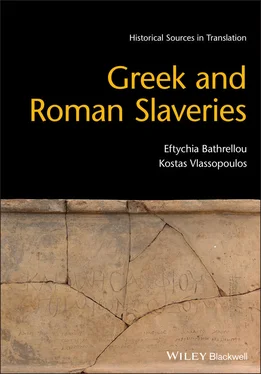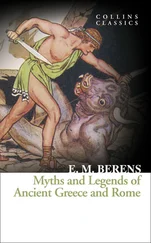The years during which we prepared this book were sadly marked by the death of many of our loved ones. This book is dedicated to the memory of our fathers, Gerasimos Vlassopoulos and Stavros Bathrellos, and of EB’s great aunt Metaxia Anaplioti; their sagacity and their love guided us, gave us strength, and to a great extent shaped our lives.
Slavery was a ubiquitous and fundamental phenomenon of Greek and Roman societies. Slaves constituted a substantial proportion of the population of ancient communities. They worked in practically all sectors of ancient economies, as agricultural workers, artisans, traders, servants, performers, managers, and even civil servants. Their exploitation allowed their masters to live as they wished; the domination of slaves shaped the formation of households, relations of gender, constructions of identity, and cultural practices. Slavery was used as a powerful tool to think about hierarchy, power, religion, and the good life. There is hardly any aspect of ancient history, literature, or archaeology that does not involve, in one way or another, slaves and slavery. Consequently, a sourcebook on ancient slavery has immense value for those interested in the study of Classics, ancient history, and classical archaeology.
The volume at hand is not the first slavery sourcebook. There exist two older sourcebooks on ancient slavery; one in English, by Thomas Wiedemann, that covers both Greek and Roman slavery, 1and one in German, by Werner Eck and Johannes Heinrichs, that focuses on the Roman imperial period. 2Both are still valuable works, and we have tried as far as possible to avoid duplicating their contributions and their selection of texts. 3Instead, our sourcebook tries to present different texts and new topics and uses an alternative, interactive format. We have tried to design a sourcebook that is both user-friendly and at the same time an introduction to the sources and scholarship on Greek and Roman slaveries. Each chapter is preceded by an introduction, which lays out the wider issues examined in the chapter. Each source is accompanied by a small introduction, setting the context and providing necessary information, references to relevant scholarly literature, and a series of questions, which aim to help readers to analyze and debate each source. To help readers focus on how a source illuminates the issues under examination, we have limited the information we offer to the absolutely necessary. We have tried to ensure that each source and question can be studied productively solely on the basis of the evidence provided in the sourcebook. At the same time, by offering bibliographical suggestions, we have tried to make each source a window to the wider scholarship and an opportunity to explore further the issues that each source raises. 4All translations of sources are our own, specifically made with the readership of this volume in mind.
This sourcebook includes a substantial number of sources that are relatively unknown or have never been examined in connection with slavery. We have also made a serious effort to include some of the material and visual evidence for ancient slaves and slavery and to examine some issues using more than one types of evidence. Nevertheless, we deeply regret that our linguistic limitations meant that we have only included sources written in Greek and Latin. The study of ancient slaveries needs to move beyond the usual focus on Greek and Roman slaveries and engage seriously with slavery in Mesopotamia, Syria, Anatolia, Egypt, the Punic world, Italic societies (Etruscans, Oscans), and temperate Europe. 5We cannot achieve this wider aim in this work; hence, this is a sourcebook of Greek and Roman slaveries rather than ancient slaveries. But we have tried to use Greek and Roman sources as evidence for other slave systems (Anatolian, Jewish, Celtic, Germanic, Sarmatian) and to point out consistently their similarities with and differences from the better-known Greek and Roman slave systems. We also emphasize the diversity of these systems. The study of Greek slavery usually focuses on classical Athens, while that of Roman slavery is usually geared toward republican and imperial Rome and Italy. Other areas and periods, like the Hellenistic and early imperial Eastern Mediterranean, or late antiquity, are often ignored in synthetic, non-specialist surveys. We have tried to maintain a chronological and geographical balance, from the archaic period to late antiquity and including the whole of the Mediterranean and its adjacent areas, within the limits of the available evidence.
Finally, our selection of sources has been guided by our selection of topics. We have obviously included important topics that have always generated important research, such as the brutality of slavery, the economic exploitation of slaves, and the practices of manumission and the conditions of freedpersons. At the same time, we wish to present new topics, perspectives, and approaches, which have been at the forefront of innovative research in the last fifteen years. Earlier approaches tended to see slavery from a unilateral and top-down perspective, as a relationship defined exclusively by the masters. This meant that slavery was approached as a static institution, while slaves were largely seen as passive objects of domination and exploitation. We have adopted a processual approach, which explores the variety of economic, social, political processes and contexts within which slavery was employed for a variety of purposes; at the same time, while masters played a major role in the historical configuration of slavery, the agency of enslaved persons and other groups and factors (the state, religious groups, voluntary associations) was also significant. The involvement of various processes, contexts, and agents generated important contradictions and conflicts, as well as both widespread diversity and convergent tendencies. We thus devote chapters to the various slaving strategies of masters and the dialectical relationships between masters and slaves, free and slave, and the communities of enslaved persons. In addition, we attempt a systematic comparison of ancient slave systems while also exploring how they changed in the course of the 1500 years of ancient history. Finally, while slavery is usually approached as a socioeconomic phenomenon, recent work has put at the forefront its cultural and political aspects. We have thus devoted substantial space to the geopolitical setting of ancient slave systems and the role of slaves within cultural and religious processes.
All these various factors and topics were, of course, interrelated, and this means that the sources we have selected can be profitably juxtaposed and examined from a variety of viewpoints. We have included extensive cross-references to enable readers to explore sources in different contexts than those we have placed them; the detailed index is also a tool for using the sourcebook in multiple and alternative ways. We hope that this volume adequately reflects the diversity and richness both of the ancient evidence for slavery, as well as its modern scholarly study.
1 1 Wiedemann 1981.
2 2 Eck and Heinrichs 1993.
3 3 For other important collections of sources on ancient slavery, see Scholl 1990; CRRS.
4 4 For the voluminous scholarship on ancient slavery, see the search engine at http://sklaven.adwmainz.de/index.php?id=1584.
5 5 Lewis 2018; Vlassopoulos 2021a.
What is slavery? Modern scholarship has largely focused on two definitions: slaves were human property, 6and slavery is a form of social death: the violent domination of dishonored outsiders without acknowledged kinship links (natal alienation). 7There is no shortage of ancient sources that support these two definitions (1.1, 1.11–2, 1.14). On this basis, scholars have constructed a stereotype of slaves as outsiders acquired through trade or war (1.2) who lived and worked under the direct control of their masters.
Читать дальше












